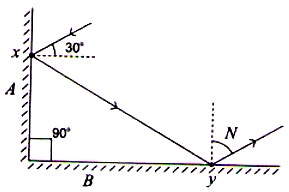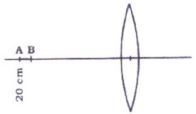Two similar thin equi-convex lenses, of focal length f each, are kept coaxially in contact with each other such that the focal length of the combination is . When the space between the two lenses is filled with glycerin which has the same refractive index () as that of glass, then the equivalent focal length is . The ratio will be:
1. 3 : 4
2. 2 : 1
3. 1 : 2
4. 2 : 3

To unlock all the explanations of 14 chapters you need to be enrolled in MasterClass Course.

To unlock all the explanations of 14 chapters you need to be enrolled in MasterClass Course.
A ray of light falls on a plane mirror A kept at an angle 90 to mirror B as shown in the figure. The angle N is :

1. 30
2. 45
3. 60
4. 90

To unlock all the explanations of 14 chapters you need to be enrolled in MasterClass Course.

To unlock all the explanations of 14 chapters you need to be enrolled in MasterClass Course.

To unlock all the explanations of 14 chapters you need to be enrolled in MasterClass Course.

To unlock all the explanations of 14 chapters you need to be enrolled in MasterClass Course.
A concave lens gives a virtual image. In optical lenses worn by humans which of the following statements is true?
1. The lens can never be concave.
2. In some cases, the lens can be concave if the focal length is much larger than 2.5 cm.
3. All focal length concave lenses are possible.
4. All focal length Convex lenses are possible.

To unlock all the explanations of 14 chapters you need to be enrolled in MasterClass Course.

To unlock all the explanations of 14 chapters you need to be enrolled in MasterClass Course.
A ray of light in air is incident on an equilateral glass prism at an angle to the normal. After refraction, the light traveled parallel to the base of prism and emerged in the air at an angle to the normal. If the angle between the incident and the emergent rays is 60 then the refractive index of glass with respect to air is :
1. 1.33
2. 1.5
3. 1.73
4. 1.66

To unlock all the explanations of 14 chapters you need to be enrolled in MasterClass Course.

To unlock all the explanations of 14 chapters you need to be enrolled in MasterClass Course.
You are standing on the shore of a lake. You spot a fish swimming below the lake surface. You want to kill the fish first by throwing a spear and next, by pointing a high-power laser torch. How should you aim the spear and torch, respectively, from the options given below?
I. above the apparent position of the fish
II. below the apparent position of the fish
III. directly at the apparent position of the fish
1. SPEAR: II : LASER: III
2. SPEAR: I : LASER: II
3. SPEAR: II : LASER: II
4. SPEAR: III : LASER: III

To unlock all the explanations of 14 chapters you need to be enrolled in MasterClass Course.

To unlock all the explanations of 14 chapters you need to be enrolled in MasterClass Course.
A beam of light coming from a rarer medium is partially reflected from the surface of a denser medium and partially refracted into the denser medium. If the reflected and the refracted rays are perpendicular to each other and the ratio of the refractive indices of the denser and rarer medium is , the angle of refraction will be -
1.
2.
3.
4.

To unlock all the explanations of 14 chapters you need to be enrolled in MasterClass Course.

To unlock all the explanations of 14 chapters you need to be enrolled in MasterClass Course.
A person can see clearly only the objects situated in the range of 50 cm to 300 cm. He went to an optometrist who prescribed him a lens of a certain power to increase the maximum distance of his vision to infinity, i.e., it corrected the nearsightedness. However, upon using the prescribed lens the person discovered that the near point of his vision has shifted from 50 cm to a distance "d". What is the value of d?
1. 60 cm
2. 100 cm
3. 40 cm
4. 500 cm

To unlock all the explanations of 14 chapters you need to be enrolled in MasterClass Course.

To unlock all the explanations of 14 chapters you need to be enrolled in MasterClass Course.
A convex lens and a concave lens, each of focal length 10 cm, are kept separated by a distance of 2 cm as shown in the figure. If the light is incident from left, the combinations of lenses will be _____.

1. Converging
2. Diverging
3. Behaving like a glass slab
4. Converging or diverging depending on whether the lenses are arranged as shown in the figure
or in the reverse order.

To unlock all the explanations of 14 chapters you need to be enrolled in MasterClass Course.

To unlock all the explanations of 14 chapters you need to be enrolled in MasterClass Course.
A pin AB of length 2 cm is kept on the axis of a convex lens between 18 cm and 20 cm as shown in figure. Focal length of convex lens is 10 cm. Find magnification produced for the image of the pin.

1. 0.83
2. 1.00
3. 1.25
4. 6.78

To unlock all the explanations of 14 chapters you need to be enrolled in MasterClass Course.

To unlock all the explanations of 14 chapters you need to be enrolled in MasterClass Course.










